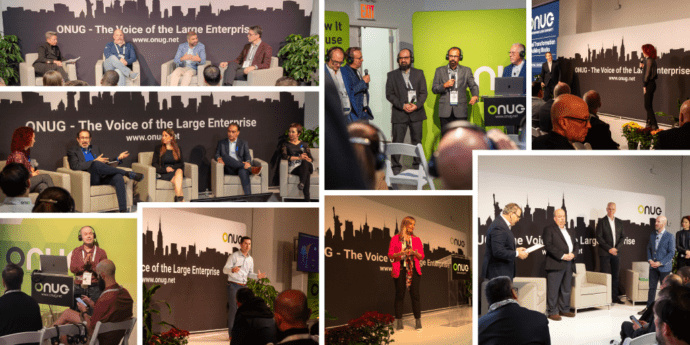
The Impact of AI on Enterprise Networks
You can’t escape it: artificial intelligence is defining the current era of technology whether we like it or not. Although AI has been around in various forms for decades (the concept of a neural network model was first proposed in the 1940s!), the transformer model architecture, recent advent of LLMs, and significant advancements in computational hardware have armed us with AI capabilities that have never been seen before. All of a sudden, computers are capable of complicated natural language processing tasks requiring long-range context, allowing applications to do all sorts of things typically handled by humans.
Exciting, right? Unfortunately, getting these exciting theoretical benefits from LLMs is a bit more daunting than it seems, and requires some real infrastructure optimization work from enterprise IT teams and network engineers. In this post, we’ll dig into the state of AI in the enterprise today, how AI is impacting the enterprise WAN topology, and how AI can benefit enterprise network management.
The State of AI in the Enterprise in Q3 2024
If 2023 was when generative AI became “hot,” 2024 is when it began to hit the enterprise. Over 65% of enterprises are now utilizing generative AI regularly in some capacity per a recent McKinsey survey. Initially, there was an infatuation phase with AI tooling and a “spaghetti on the wall” approach to trying all sorts of tooling any which way, but today enterprises are laser-focused on value creative use cases and demanding results from AI tooling utilized.
LLMs are not purpose-built for everything. The most common LLM use cases today seen in enterprises align with where natural language processing and generation is key: content creation, personalized marketing, design development, IT help desk chatbot / assistant, etc. Given the novel nature of AI tooling, enterprises are still facing issues building trust with AI (accuracy is an issue, as models may hallucinate and aren’t deterministic in query responses) and evolving workflows around AI (changing habits and headcount). Further, enterprises are facing significant security concerns around AI tooling, as they don’t want employees sharing sensitive information with their cloud provider / application software providers.
AI’s Impact on the Enterprise WAN
Even though AI tooling utilization across the enterprise is likely still in its infancy, its compute and data intensive nature is already changing the shape of enterprise WANs. Here are some trends we’ve observed at Lightyear with enterprises embracing AI.
- Compute-Intensive Data Centers: AI tooling may involve self-hosting and training of models which requires significant ingress and egress of data and lots of GPU-intensive compute
- More WAN Nodes / Higher Bandwidth: There may be more links in the overall enterprise WAN, at higher bandwidth to support increased data transmission needs
- Latency Optimization: Enterprises are more likely to have edge data center nodes (higher quantity and strategically located) or colocation space that’s strategically positioned for optimized compute and lower latency
- Private / Hybrid / Multi Cloud: Enterprises heavily utilizing AI are more likely to embrace private cloud offerings, or shift to a hybrid-cloud and / or multi-cloud architecture to ensure scalability and adaptability of their network overall
- Direct Cloud Connectivity: If utilizing the public cloud for AI, enterprises are more likely to add direct cloud connect links for higher bandwidth cloud connectivity at lower latency
- WAN Orchestration Software: SD-WAN and WAN orchestration software are more important, as network performance is becoming more important, and SD-WAN services with a robust middle-mile network are more valuable
AI’s Impact on Network Management
AI is not just impacting WAN topologies, it’s also impacting network management and operations! LLMs, and applications that utilize them, are already helping enterprises accomplish more with less when it comes to network ops. See below for some exciting (and real!) LLM use cases in this arena.
- Improved Troubleshooting and Issue Resolution: AI can analyze vast amounts of data to identify the root causes of network problems, providing insights to IT teams to quickly isolate and resolve issues
- Network Optimization / Self-Healing Networks: AI analyzes network operations and traffic patterns to reduce latency and improve performance, automating routine tasks like configuration of network settings. Over time, these systems can learn from past performance to adjust.
- Enhanced Network Security: AI can analyze network traffic patterns to identify anomalies and security threats in real time, speeding up detection and response
- Predictive Maintenance and Proactive Problem-Solving: AI uses predictive analytics to anticipate network issues before they happen, forecasting resource utilization, system failures, and performance issues
- Intelligent Assistants: AI assistants can answer user queries and address specific problems through intuitive interfaces, reducing the burden on IT teams
You may have read the above and thought “Amazing! Now how do I get this done in my enterprise?” I won’t plug any specific applications or services here, but a number of companies are working on solutions to address these issues with AI, and a quick Google search will send you in the right direction. That, or if the solution is bespoke enough, building an application in-house could be worthwhile (and is easier than ever).
Learn more in the webinar Simplifying Telecom Procurement & Management with AI, Automation, and Data.



